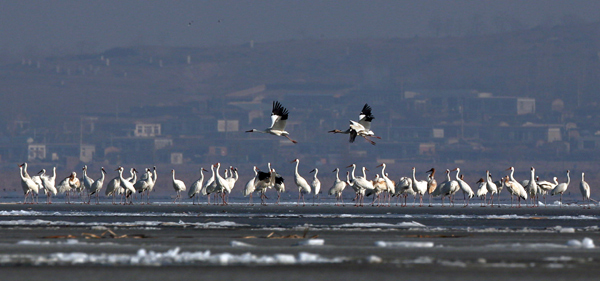White Crane dance takes flight
By Gao Anming, He Na and Wu Yong (China Daily) Updated: 2014-04-03 08:18
|
 |
|
White cranes during their stay in Huanzidong, Liaoning province. Photos by Zou Hong / China Daily |
After spending almost three decades observing the birds, Wang Zhenyou is something of an expert and is often consulted by staff from the local forestry bureau. He keeps a diary in which he details the birds' movements and always has firsthand data relating to their arrival and departure.
Faku holds a white crane festival every year. This year it began on March 30 and will run until the middle of May. When he's not on patrol, Wang volunteers to guide visitors around the wetland.
"I know where the birds nest and can help the visitors save valuable time. I also remind them not to disturb the birds. I am very proud to live here," he said.
Qian Fawen, an ornithological expert from the China Academy of Forestry, confirmed the importance of protecting the white cranes. "They only hunt in shallow water, so controlling and providing a suitable water level is vital to their survival," Qian said.
Wetland protection
"To protect the wetlands scientifically, we invited some well-known experts to come and brainstorm. They made some good suggestions," Party secretary Feng said.
Often called the kidneys and lungs of the earth, China's wetlands are fundamental to the country's water resources. They feed downstream waters, trap floodwater, recharge the supply of groundwater, remove pollution, and provide a habitat for fish and wildlife. The wetlands also have an economic function through their role in sectors such as fishing, hunting, agriculture and recreation.
In January, the State Forestry Administration released the Second National Wetlands Recourses Census. The comprehensive five-year survey shows that China has 53.6 million hectares of wetland, accounting for 5.58 percent of the country's territory.
According to Zhang Yongli, deputy director of the administration, 96 percent of China's available freshwater resources come from wetlands, which also play an important role in combating climate change and provide a habitat for 2,312 kinds of vertebrates, including 231 bird species, and are also home to around 4,220 plant varieties.
The survey shows that China has 577 natural preserves and 468 wetland parks, and that the area under protection has increased by 5.26 million hectares from 23.24 million hectares compared with 2009.
Despite the increase, there is no real cause for optimism, according to Zhang: "Wetlands coverage has fallen by 3 million hectares during the past decade, and the destruction caused by humans is the main cause. China's wetlands still face many problems, including the reduction of coverage, function degradation and a lack of protection. More importantly, nationwide protection regulations and a long-term protection mechanism have yet to be established. All of this has hindered our progress in terms of protecting the wetlands. Technological support is also very weak and public awareness of protection needs to improve."
Zhang's view was echoed by Zhou Jingbo, an associate professor at Renmin University's School of Environment and Natural Resources, who said: "Protection of wetlands revolves around solving the problems arising from the relationship between protection and rational use. We must accelerate the process of establishing protection laws and regulations to clearly define the layout, treatment and development. We must take protection out of the hands of the State Forestry Administration and establish a long-term management mechanism that involves a number of government departments and institutes," he said.
For Zhang, the solution is simple: "We must ensure that the coverage of China's wetlands is no less than 53.33 million hectares by 2020, and defend them resolutely."
Liu Ce contributed to this story.
- More female officials caught in corruption
- Whampoa veterans recorded with glory
- Police bust 9 terrorist groups in Xinjiang
- Knife-wielding attackers seized in Xinjiang
- New regulation leads to drop in petitioned cases
- Hunan plant shut as probe into lead poisoning begins
- Police boost efforts to combat gambling
- Project offers jobs openings to legal experts
- Experts: Dog meat festival 'illegal'
- Nation looks to upgrade
pipeline networks






